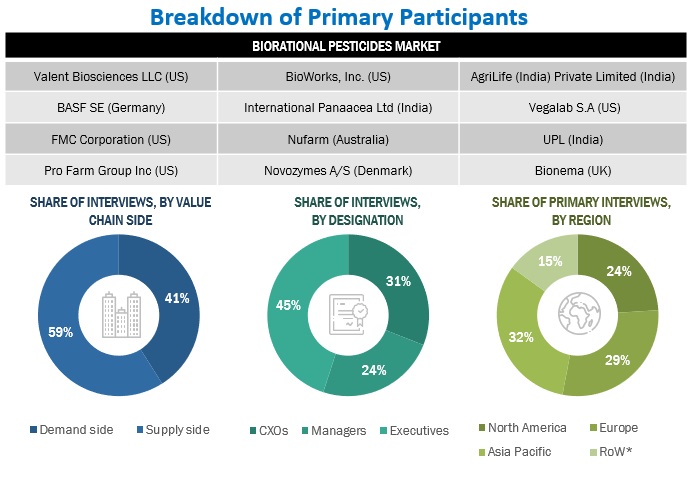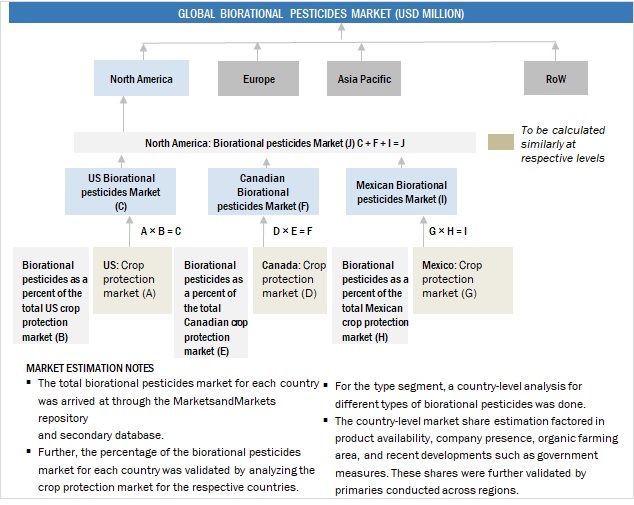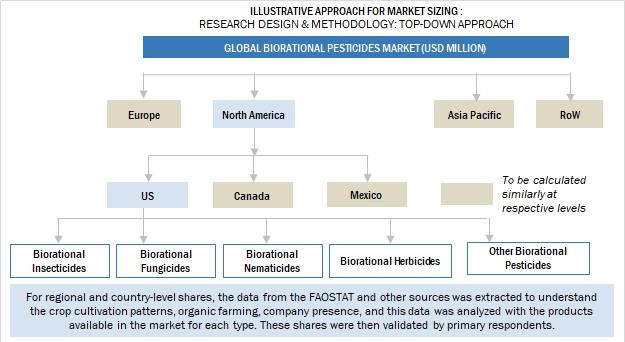The study involved four major activities in estimating the current size of the biorational pesticides market. Exhaustive secondary research was done to collect information on the market, peer market, and parent market. The next step was to validate these findings, assumptions, and sizing with industry experts across the value chain through primary research. Both top-down and bottom-up approaches were employed to estimate the complete market size. After that, market breakdown and data triangulation were used to estimate the market size of segments and subsegments.
Secondary Research
This research study involved the extensive use of secondary sources—directories and databases such as Bloomberg Businessweek and Factiva—to identify and collect information useful for a technical, market-oriented, and commercial study of the market.
In the secondary research process, various sources such as annual reports, press releases & investor presentations of companies, white papers, agriculture journals, certified publications, articles from recognized authors, gold & silver standard websites, directories, and databases, were referred to identify and collect information. This research study involved the extensive use of secondary sources—directories and databases such as Bloomberg Businessweek and Factiva—to identify and collect information useful for a technical, market-oriented, and commercial study of the biorational pesticides market.
Secondary research was mainly used to obtain key information about the industry’s supply chain, the total pool of key players, and market classification and segmentation as per the industry trends to the bottom-most level, regional markets, and key developments from both market- and technology-oriented perspectives.
Primary Research
Extensive primary research was conducted after obtaining information regarding the biorational pesticides market scenario through secondary research. Several primary interviews were conducted with market experts from both the demand and supply sides across major countries of North America, Europe, Asia Pacific, the Middle East & Africa, and South America. Primary data was collected through questionnaires, emails, and telephonic interviews. The primary sources from the supply side included various industry experts, such as Chief X Officers (CXOs), Vice Presidents (VPs), Directors, from business development, marketing, research, and development teams, and related key executives from distributors, and key opinion leaders. Primary interviews were conducted to gather insights such as market statistics, data on revenue collected from the products and services, market breakdowns, market size estimations, market forecasting, and data triangulation. Primary research also helped in understanding the various trends related to types of biorational pesticides, type, mode of application, source, formulation, crop type, and region. Stakeholders from the demand side, such as opinion leaders, growers, farmers, and agronomists who are using biorational pesticides were interviewed to understand the buyer’s perspective on the suppliers, products, and their current usage of biorational pesticides and the future outlook of their business which will affect the overall market.

To know about the assumptions considered for the study, download the pdf brochure
Market Size Estimation
Both the top-down and bottom-up approaches were used to estimate and validate the total size of the biorational pesticides market. These approaches were also used extensively to estimate the size of various dependent submarkets. The research methodology used to estimate the market size includes the following:
-
Key players were identified through extensive secondary research.
-
The industry’s value chain and market size were determined through primary and secondary research.
-
All percentage share splits and breakdowns were determined using secondary sources and verified through primary sources.
-
All the possible parameters that affect the markets covered in this research study were accounted for, viewed in extensive detail, verified through primary research, and analyzed to obtain the final quantitative and qualitative data.
-
The parent market—the crop protection market—was considered further to validate the details of the market.
-
The following figure provides an illustrative representation of the complete market size estimation process implemented in this research study for an overall estimation of the market in a consolidated format.
The following sections (bottom-up & top-down) depict the overall market size estimation process employed for the purpose of this study.
Global Biorational Pesticides Market: Bottom-Up Approach

To know about the assumptions considered for the study, Request for Free Sample Report
Global Biorational Pesticides Market: Top-Down Approach

Data Triangulation
After arriving at the overall market size from the estimation process explained above, the total market was split into several segments and subsegments. The data triangulation and market breakdown procedures were employed, wherever applicable, to estimate the overall biorational pesticides market and arrive at the exact statistics for all segments and subsegments. The data was triangulated by studying various factors and trends from the demand and supply sides. Along with this, the market size was validated using both the top-down and bottom-up approaches.
Market Definition
According to a paper published by IPM Florida & the University of Florida, the term “biorational” describes those pesticides that are efficient against target pests but are less detrimental to natural enemies. In this report, a biorational pesticide is defined as “any type of pesticide active against pest populations, but relatively innocuous to non-target organisms and therefore, non-disruptive to the environment’s biological control.
Biorational pesticides are derived from natural biological materials such as animals, plants, bacteria, and certain minerals. They are third-generation pesticides that are environment-friendly and closely resemble or are identical to chemicals produced biologically in nature.
Key Stakeholders
-
Agriculture pesticide manufacturers & suppliers
-
Associations and industry bodies
-
Biorational pesticide manufacturers & suppliers
-
Biorational pesticide traders, retailers, and distributors
-
Commercial research & development (R&D) institutions
-
Venture capitalists and investors
-
Government, regulatory bodies, and research organizations
-
Technology providers to biorational pesticide & microbial companies
-
Public hygiene organizations, government regulatory institutions, and food safety agencies
-
Associations and industry bodies
Report Objectives
Market Intelligence
-
Determining and projecting the size of the market, based on type, formulation, mode of application, source, crop type, and regional markets, over a five-year period, ranging from 2023 to 2028.
-
Identifying attractive opportunities in the market by determining the largest and fastest-growing segments across regions
-
Analyzing the demand-side factors based on the following:
-
Impact of macro- and microeconomic factors on the market
-
Shift in demand patterns across different subsegments and regions
Competitive Intelligence
-
Identifying and profiling the key market players in the market
-
Determining the share of key players operating in the biorational pesticides market
-
Providing a comparative analysis of the market leaders on the basis of the following:
-
Product offerings
-
Business strategies
-
Strengths, weaknesses, opportunities, and threats
-
Key financials
-
Understanding the competitive landscape and identifying major growth strategies adopted by the key companies.
-
Analyzing the patents registered and regulatory frameworks across the regions and their impact on prominent market players.
-
Analyzing the market dynamics and competitive situations & trends across the regions and their impact on prominent market players
Available Customizations:
With the given market data, MarketsandMarkets offers customizations according to company-specific scientific needs.
The following customization options are available for the report:
Product Analysis
-
Product Matrix, which gives a detailed comparison of the product portfolio of each company.
Geographic Analysis
With the given market data, MarketsandMarkets offers customizations according to company-specific scientific needs.
-
Further breakdown of the Rest of Europe into Netherlands, Poland, and other EU & non-EU countries
-
Further breakdown of the Rest of Asia Pacific into New Zealand, Thailand, and Vietnam.
-
Further breakdown of the Rest of South America into Colombia, Paraguay, Peru, and other South American countries
Company Information
-
Detailed analyses and profiling of additional market players (up to five)



mahrous
Dec, 2021
Very informative market report..